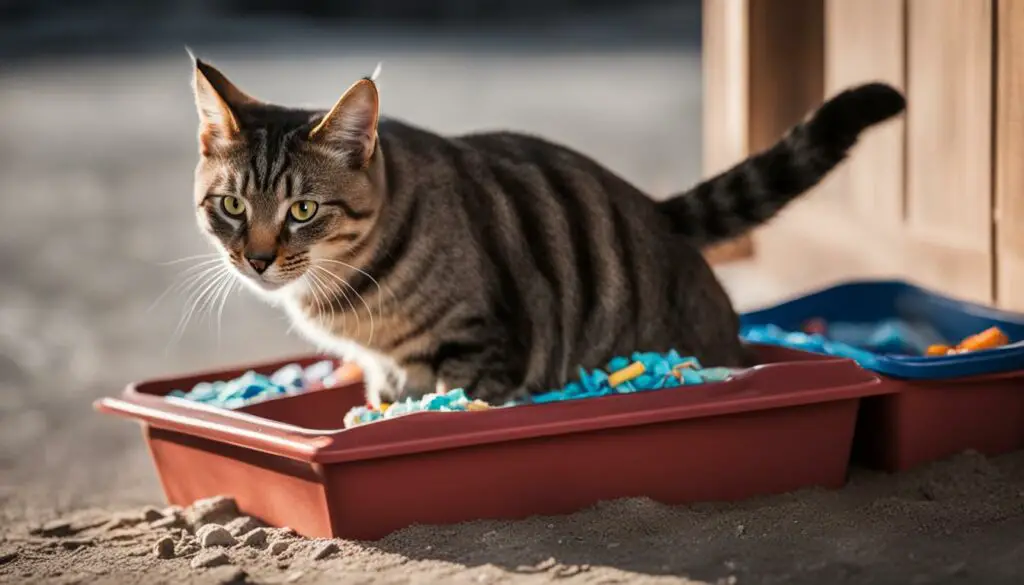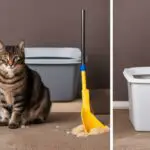Hello, fellow cat owners! If you’re reading this, you may be facing the challenge of retraining your beloved feline to use the litter box after a urinary tract infection (UTI) episode. Don’t worry, I’m here to help you navigate through this process with ease.
Proper litter box training is essential for maintaining a clean and harmonious household. Cats naturally prefer consistency and a tidy environment for their bathroom needs. By following a few simple steps, you can successfully retrain your cat to use the litter box, ensuring both their hygiene and your peace of mind.
Key Takeaways:
- Retraining a cat to use the litter box after a UTI is achievable with the right approach.
- Cats prefer a clean and accessible litter box, so regular maintenance is crucial.
- Choosing the right litter box and litter can significantly impact your cat’s preference for using it.
- Positive reinforcement and patience are key to successful litter box training.
- Addressing any underlying issues or changes in the cat’s environment can help maintain litter box use.
The Importance of Litter Box Training for Cats
Litter box training is an essential aspect of cat care that plays a significant role in their behavior and hygiene. Cats who are not properly trained to use the litter box can cause disruptions in the household, leading to frustration and stress for both the cat and their owners. By understanding the importance of litter box training, cat owners can ensure a clean and peaceful environment for their furry friends.
Cats are creatures of habit and prefer consistency when it comes to their bathroom routine. Providing them with a clean and accessible litter box allows them to maintain a sense of familiarity and security. A dirty or poorly maintained litter box can discourage cats from using it, leading to accidents and inappropriate elimination in other areas of the home.
In addition to maintaining cleanliness, litter box training is crucial for a cat’s hygiene and overall well-being. Using a litter box helps to contain and manage waste, preventing the spread of odor and bacteria. It also allows owners to monitor their cat’s urinary and bowel movements, providing valuable insights into their health. Regular use of the litter box promotes good litter box habits and ensures that cats can easily and comfortably relieve themselves.
By prioritizing litter box training, cat owners can create a positive environment that promotes good behavior and hygiene. Consistency, cleanliness, and accessibility are key factors when it comes to successful litter box training. Providing cats with a designated and well-maintained litter box encourages them to develop the habit of using it, leading to a happy and healthy coexistence between cats and their owners.
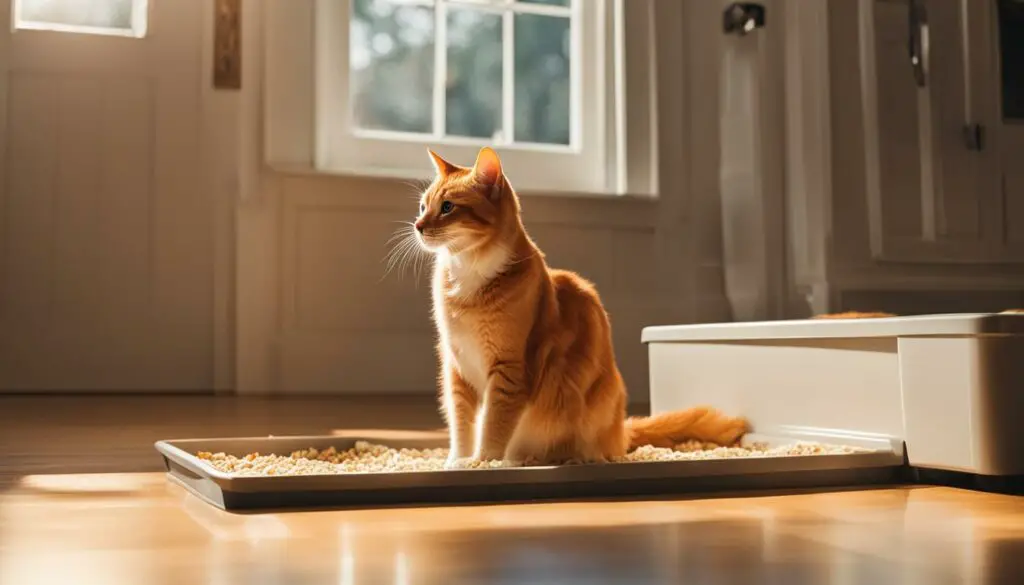
The Importance of Litter Box Training for Cats
Choosing the Right Litter Box
When it comes to litter box training, choosing the right litter box is crucial for your cat’s comfort and success. Cats have different preferences, and finding the right litter box can make a significant difference in their litter box training journey.
Types of Litter Boxes
There are several types of litter boxes available in the market, each with its own pros and cons. It’s important to consider your cat’s size, preference, and your home environment when selecting a litter box.
A covered litter box provides privacy and helps contain odors, which can be ideal for cats who prefer privacy. However, some cats may feel trapped or confined in a covered litter box, so it’s essential to observe your cat’s behavior and make adjustments accordingly.
On the other hand, an open litter box allows more air circulation and easier access. This type of litter box is suitable for cats who prefer an open and spacious environment. It’s also easier to clean and monitor the litter level in an open litter box.
Size and Accessibility
The size of the litter box is also an important factor to consider. It should be spacious enough for your cat to comfortably turn around and dig. If your cat is a larger breed, a larger litter box may be necessary.
Additionally, the accessibility of the litter box is crucial. Cats prefer a quiet and peaceful area for their litter box, so placing it away from loud appliances or high-traffic areas is recommended. Make sure the litter box is easily accessible for your cat, especially if they have mobility issues or are older in age.
Summary
In summary, choosing the right litter box is a crucial step in your cat’s litter box training journey. Consider your cat’s preferences, size, and your home environment when selecting a litter box. Whether you opt for a covered or open litter box, ensure it provides enough space and accessibility for your cat to comfortably use it. By selecting the right litter box, you can set your cat up for successful litter box training and maintain their hygiene and well-being.
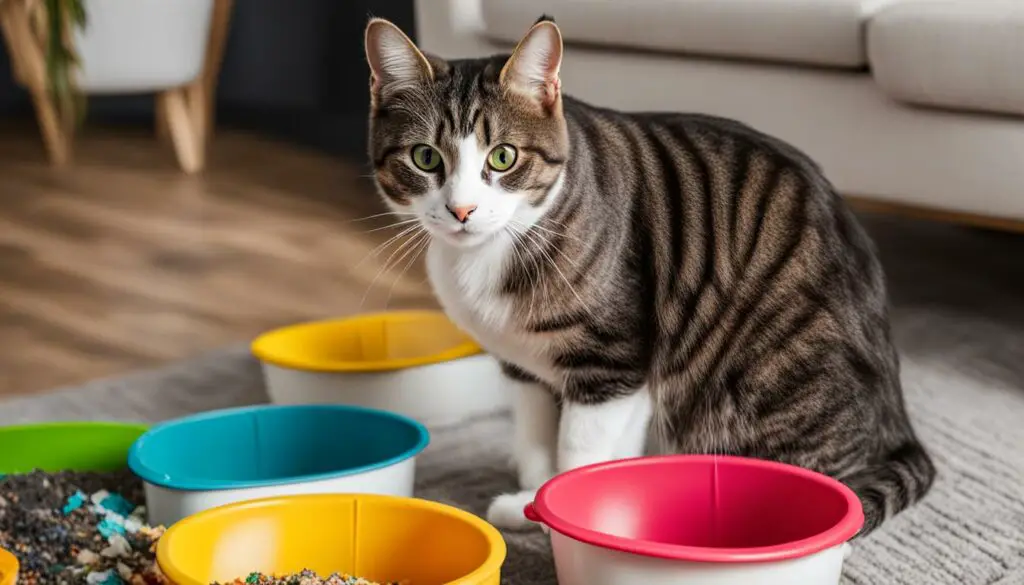
Selecting the Proper Litter
When it comes to selecting the right litter for your cat, it’s important to consider their preferences and needs. The type of litter you choose can greatly impact their willingness to use the litter box. Cats have sensitive noses, so opt for unscented litter to avoid potentially overwhelming their senses. Additionally, clumping litter may not be favored by all cats, as some may find it uncomfortable to walk on. To ensure your cat feels comfortable and secure, provide enough litter depth for them to properly bury their waste. This helps maintain their natural instincts and promotes good litter box habits.
It’s also worth noting that some cats may have specific litter preferences based on their breed or individual quirks. For example, long-haired cats may prefer a litter that doesn’t stick to their fur, while others may have a preference for a certain texture or material. Experimenting with different types of litter can help you determine what suits your cat’s needs best.
To help you make an informed decision, here is a table outlining some commonly used types of cat litter:
| Litter Type | Pros | Cons |
|---|---|---|
| Clay litter | • Good odor control • Cost-effective • Available in various textures |
• Dusty, which can be problematic for cats with respiratory issues • Not environmentally friendly |
| Plant-based litter (e.g., corn, wheat, pine) | • Biodegradable and eco-friendly • Naturally absorbent • Minimal dust |
• Some cats may not like the texture or scent • Can be more expensive |
| Silica crystal litter | • Excellent odor control • Low dust • Long-lasting |
• Can be more expensive • Non-biodegradable • Some cats may not like the texture |

Remember, every cat is unique, so it may take some trial and error to find the perfect litter for your feline friend. Offering multiple litter boxes with different types of litter can give your cat options and help them find their preferred choice. The goal is to create a comfortable and inviting litter box environment that encourages regular use and maintains proper hygiene for your cat.
Introducing Your Cat to the Litter Box
When it comes to litter box training, introducing your cat to the litter box is a crucial first step. By providing a positive and encouraging environment, you can help your cat understand the purpose of the litter box and establish good litter box habits. Here are some tips to help you successfully introduce your cat to the litter box:
- Place your cat in the litter box: Gently place your cat in the litter box to familiarize them with its location. This will help them associate the litter box with their bathroom needs.
- Provide positive reinforcement: Whenever your cat uses the litter box, offer praise and rewards. This will help reinforce the behavior and make them more likely to use the litter box in the future.
- Show them the location: After placing your cat in the litter box, show them where it is located in your home. Allow them to explore the area and become comfortable with their new bathroom spot.
Remember to be patient with your cat during the introduction process. It may take some time for them to fully understand and adjust to using the litter box. By providing a positive and supportive environment, you can help them develop good litter box habits and maintain proper hygiene.
Quote:
“Proper introduction to the litter box is important for cats to understand its purpose.”
Table: Litter Box Training Checklist
| Step | Action |
|---|---|
| Step 1 | Place your cat in the litter box |
| Step 2 | Provide positive reinforcement |
| Step 3 | Show them the location of the litter box |
By following these steps and providing a positive and supportive environment, you can help your cat successfully adapt to using the litter box. Keep in mind that each cat is unique, and it may take some time for them to fully adjust. Consistency and patience are key to litter box training success.
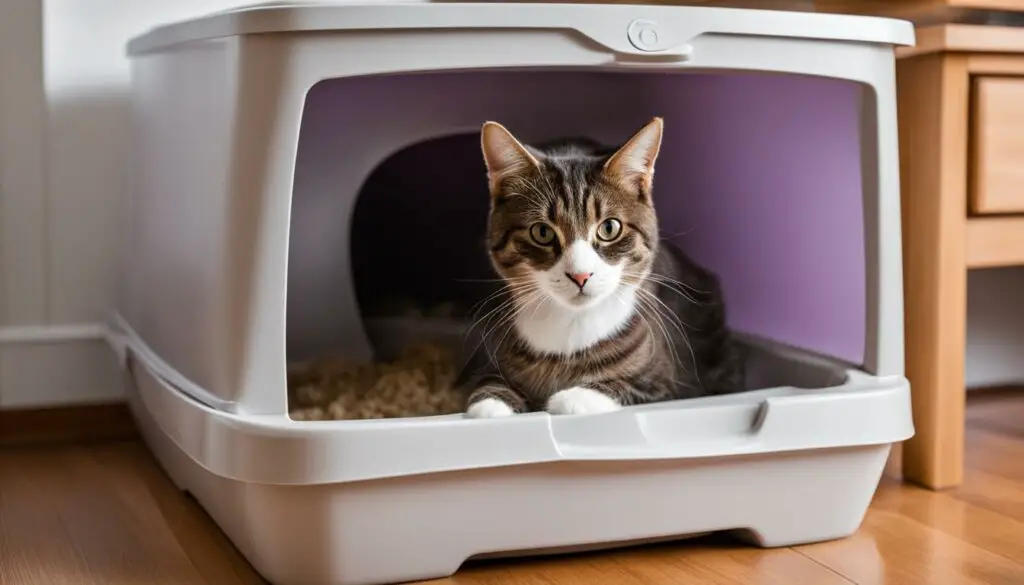
Establishing a Serene Litter Box Location
When it comes to establishing a serene and inviting litter box location for your cat, there are a few important factors to consider. Choosing the right spot can greatly impact your cat’s litter box usage and overall comfort. Here are some key tips to create a peaceful space for your feline friend:
Choose a Quiet and Private Spot
Find a quiet and private area in your home where your cat can have some privacy while using the litter box. Avoid placing it near loud appliances or high-traffic areas, as these can be stressful for cats. Creating a calm environment will help your cat feel safe and secure while using the litter box.
Ensure Accessibility and Ease of Reach
Cats prefer litter boxes that are easily accessible and effortless to reach. Make sure the litter box is placed in a location that your cat can easily find and reach without any obstacles. This will help promote regular use of the litter box and prevent accidents around the house.
Keep the Area Clean and Fresh
Maintaining a clean litter box environment is essential to encourage your cat to use it consistently. Regularly scoop the litter box to remove waste and replace the litter as needed. Cats have an acute sense of smell, and a dirty litter box can deter them from using it. By keeping the area clean and fresh, you’re providing a more inviting space for your cat to do their business.
| Benefits of a Serene Litter Box Location |
|---|
| Reduced stress: A quiet and private spot helps reduce stress and anxiety for your cat. |
| Increased litter box usage: Cats are more likely to use the litter box consistently in a serene environment. |
| Better hygiene: By establishing a peaceful litter box location, you’re promoting proper cat hygiene and minimizing accidents around the house. |
Creating a serene litter box location for your cat is an essential step in ensuring their comfort and well-being. By choosing a quiet and private spot, ensuring accessibility, and keeping the area clean, you’re providing an inviting space that encourages your cat to use the litter box regularly. Remember, cats appreciate consistency, so maintaining a serene environment will help establish good litter box habits for your furry friend.
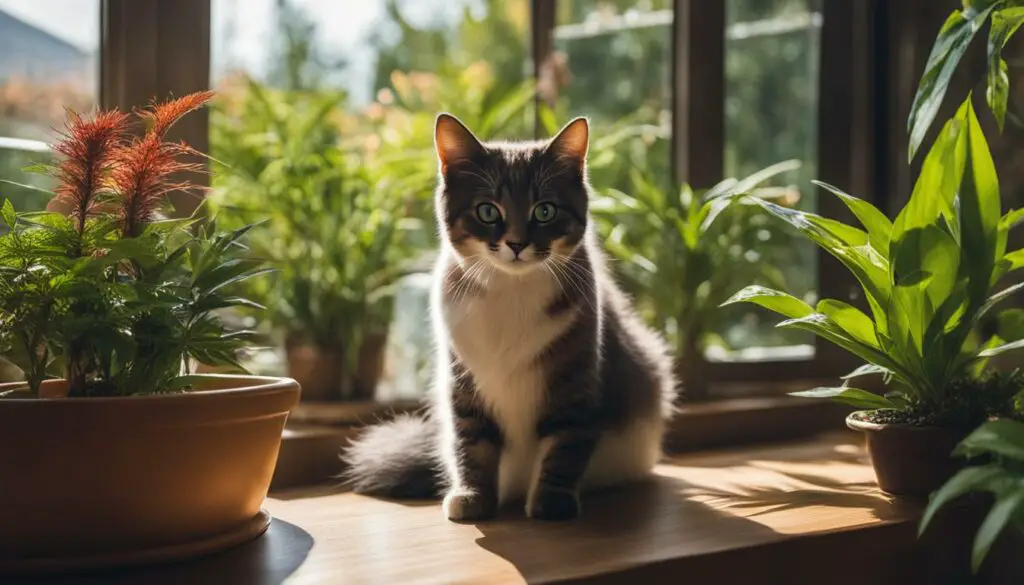
Maintaining a Clean Litter Box
Keeping the litter box clean is essential for your cat’s litter training success and overall hygiene. Cats are naturally clean animals and may avoid using a dirty litter box. Here are some tips to maintain a clean litter box:
- Scoop the litter box daily: Remove solid waste and clumps of urine-soaked litter daily to keep the litter box clean and fresh. This will also help prevent odors from building up.
- Replace the litter as needed: It is important to replace the entire litter and clean the litter box regularly. This frequency may vary depending on the number of cats in your household and their litter box usage.
- Clean the litter box with cat-safe cleansers: Use mild, cat-safe cleansers to clean the litter box on a regular basis. Avoid using harsh chemicals or strong-scented cleaners, as they may repel your cat from using the litter box.
Maintaining a clean litter box not only ensures your cat’s comfort but also promotes good litter box habits and hygiene. Regular cleaning and proper maintenance will help prevent litter box aversions and encourage consistent use.
Remember, cats prefer cleanliness, so make it a priority to provide them with a clean and pleasant litter box environment.
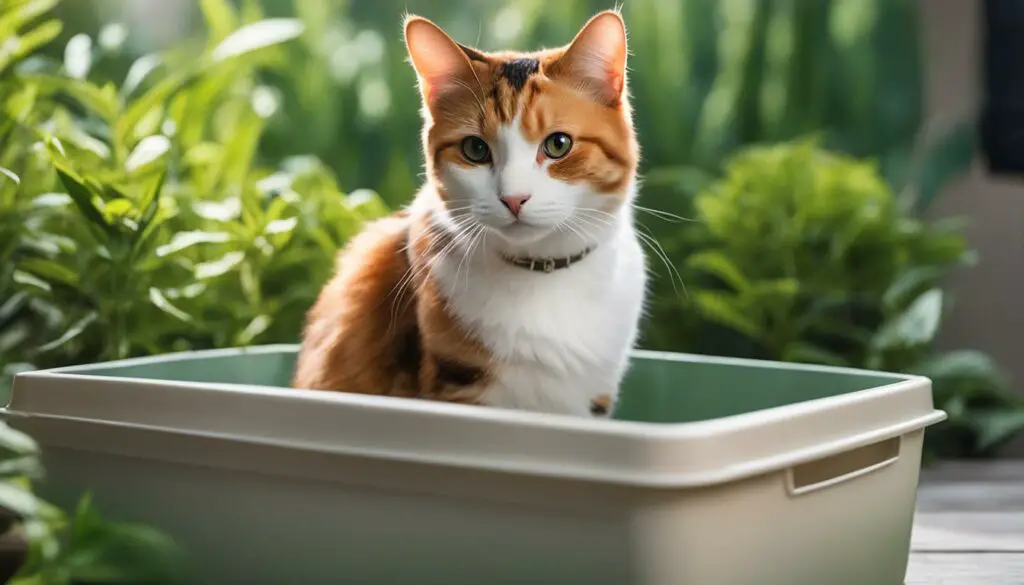
Table: Litter Box Maintenance Checklist
| Maintenance Task | Frequency |
|---|---|
| Scoop solid waste and clumps | Daily |
| Replace litter | As needed or every 1-2 weeks |
| Clean litter box | Regularly, using cat-safe cleansers |
Dealing with Litter Box Accidents
Dealing with litter box accidents can be a frustrating experience for cat owners. It’s important to approach the situation with patience and understanding, as accidents outside the litter box can often be a sign of an underlying issue. Here are some tips to help you address and resolve litter box accidents:
Identifying the Cause
When your cat has an accident outside the litter box, it’s essential to identify the cause before taking any action. Sometimes, the problem may be as simple as a dirty litter box or a change in litter type. However, it’s also crucial to consider potential medical issues, such as urinary tract infections (UTIs) or bladder stones. If you notice frequent accidents or other signs of discomfort, it’s best to consult with a veterinarian to rule out any underlying health problems.
Experimenting with Litter Box Setup
When dealing with litter box accidents, it can be helpful to experiment with different aspects of the litter box setup. Consider the size of the litter box and ensure it is spacious enough for your cat to move comfortably. Some cats prefer open litter boxes, while others prefer covered ones for added privacy. Additionally, try different types of litter to see if your cat has a preference. Cats are known for their unique preferences, so finding the right combination may require some trial and error.
Providing Positive Reinforcement
Punishing your cat for litter box accidents is counterproductive and can worsen the problem. Instead, focus on providing positive reinforcement when your cat uses the litter box correctly. Praise your cat, offer treats, or play with them after they’ve used the litter box to create positive associations. This helps reinforce the desired behavior and encourages your cat to continue using the litter box consistently.
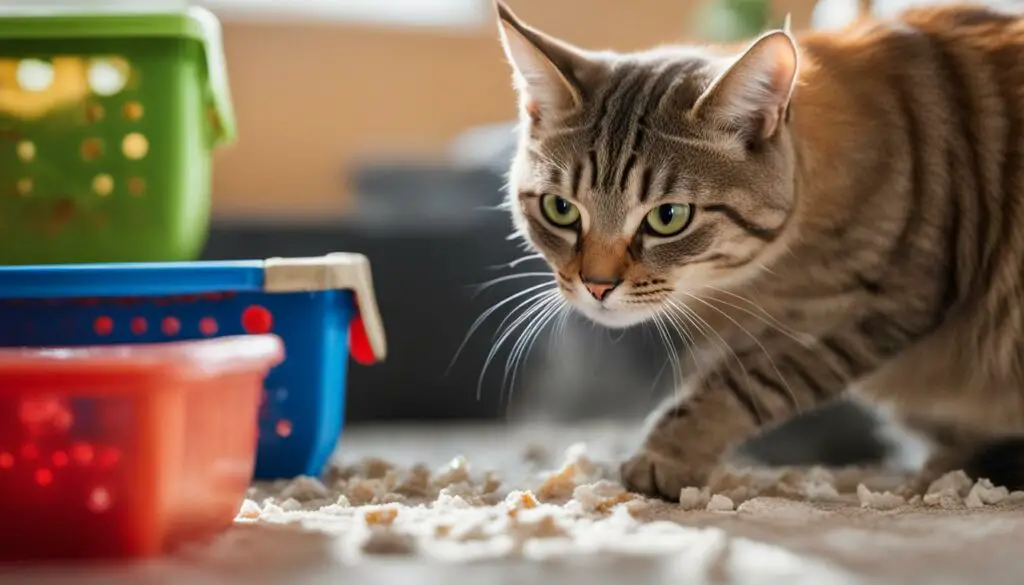
Dealing with litter box accidents requires patience and a willingness to address any underlying issues. By identifying the cause, experimenting with the litter box setup, and providing positive reinforcement, you can help your cat overcome litter box accidents and create a clean and comfortable environment for both you and your feline companion.
Avoiding Punishment and Providing Positive Reinforcement
When it comes to litter box training, punishment is not the way to go. Cats do not respond well to scolding or punishment, and it can actually worsen the problem. Instead, positive reinforcement is key to successful training. By offering praise and rewards when your cat uses the litter box correctly, you’ll encourage them to continue the desired behavior.
Positive reinforcement can take many forms. For example, you can give your cat a treat or a favorite toy when they use the litter box. You can also offer verbal praise and affection. The important thing is to make the association between using the litter box and positive experiences. This will help your cat understand that using the litter box is a good thing.
Remember to be patient and consistent with your training. It may take some time for your cat to fully grasp the concept of using the litter box. Avoid punishing accidents or showing frustration, as this can create anxiety around the litter box. Instead, focus on reinforcing the desired behavior and providing a positive environment for your cat’s litter box training.
Key Points:
- Avoid scolding or punishing your cat for litter box accidents.
- Use positive reinforcement, such as praise and rewards, to encourage proper litter box use.
- Be patient and consistent with your training.
Table: Common Positive Reinforcement Techniques
| Positive Reinforcement Technique | Description |
|---|---|
| Treats | Offer your cat a small treat each time they use the litter box correctly. |
| Toy Rewards | Give your cat their favorite toy as a reward for using the litter box. |
| Verbal Praise | Use a positive tone of voice and offer verbal praise when your cat uses the litter box. |
| Affection | Give your cat cuddles or gentle petting as a reward for proper litter box use. |
By avoiding punishment and providing positive reinforcement, you can create a positive association with the litter box for your cat. This will help them understand that using the litter box is the desired behavior. Remember to be patient and consistent, and always reward your cat for using the litter box correctly. With time and positive reinforcement, your cat will become a pro at litter box training.
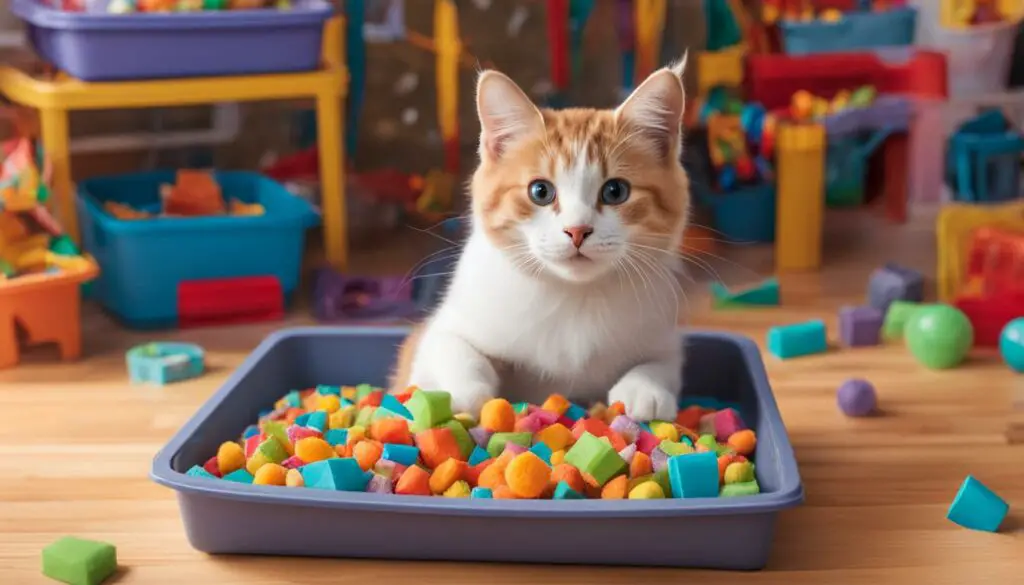
Time Frame for Litter Box Training
When it comes to litter box training, cats have varying learning curves. While kittens often grasp the concept instinctively, older cats may require some time and patience to adapt to using the litter box. The time frame for litter box training can range from a few days to a few weeks, depending on the individual cat’s behavior and receptiveness to training.
Consistency is key during the training period. Establish a routine for your cat, ensuring they have regular access to the litter box throughout the day. Place the litter box in a quiet, private spot that is easily accessible for your cat. This will help create a serene environment that encourages them to use the litter box consistently.
During the training period, it’s important to observe your cat’s behavior closely. Watch for signs that they are starting to understand and use the litter box, such as digging and burying their waste. Reinforce positive behavior by offering praise and rewards when your cat successfully uses the litter box. This will help reinforce the association between the litter box and proper elimination behavior.
Remember, every cat is unique and may require different amounts of time to fully master litter box training. If you encounter any challenges or setbacks, be patient and continue to provide consistent training and positive reinforcement. By understanding your cat’s individual needs and preferences, you can support them in developing good litter box habits for a clean and hygienic living environment.
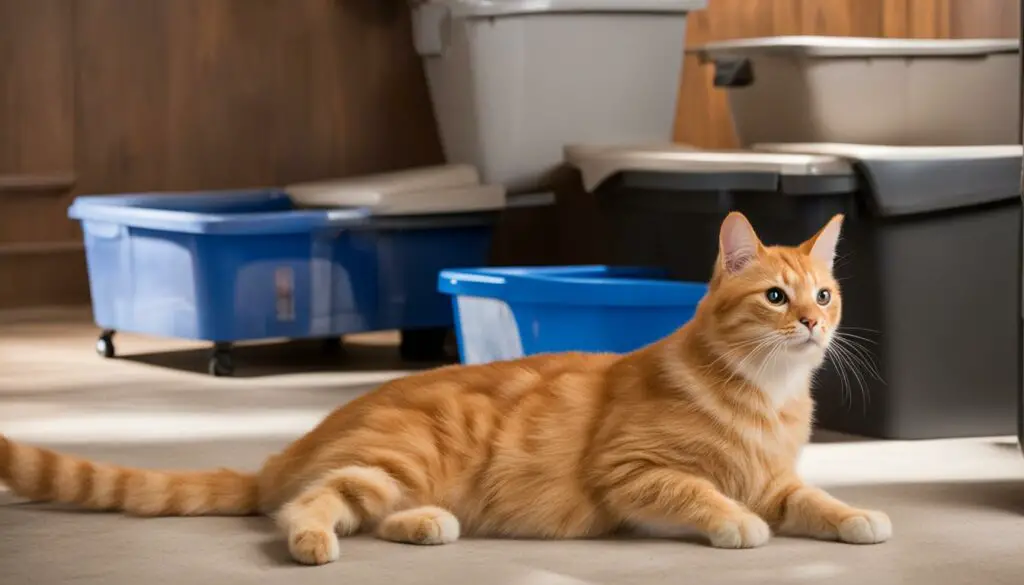
| Litter Box Training Time Frame | Factors Influencing Training Time |
|---|---|
| 1-7 days | – Kittens who learn quickly – Cats who have been previously litter trained |
| 1-2 weeks | – Adult cats adjusting to a new environment – Cats who may have had negative litter box experiences in the past |
| 2-4 weeks | – Cats with specific behavioral issues – Cats with medical conditions affecting their ability to use the litter box |
Retraining an Older Cat to Use the Litter Box
When it comes to litter box training, older cats may require some retraining, especially if they are in a new environment. Understanding the unique needs of older cats and implementing the right techniques can help them adjust and use the litter box consistently.
To begin the retraining process, it can be helpful to use soil from outside in the litter box. The familiar scent and texture of the soil can make the transition easier for the cat. Over time, gradually replace the soil with cat litter, allowing the cat to adjust to the new substrate.
Patience is key when retraining an older cat. Offer positive reinforcement, such as treats or praise, when the cat uses the litter box correctly. Avoid punishing or scolding the cat for accidents, as this can create stress and hinder the retraining process.
| Litter Retraining Steps |
|---|
| 1. Prepare the litter box: Use a clean litter box and fill it with a combination of soil and cat litter. |
| 2. Show the cat the new litter box: Gently place the cat in the litter box and allow them to explore and familiarize themselves with it. |
| 3. Transition to cat litter: Gradually replace the soil with cat litter over a period of several days or weeks. |
| 4. Offer positive reinforcement: Reward the cat with treats or praise when they use the litter box correctly. |
| 5. Be patient: Retraining an older cat may take time, so remain patient and consistent throughout the process. |
By following these steps and providing the necessary support, it is possible to retrain an older cat to use the litter box effectively. Remember to address any underlying health issues or environmental factors that may be contributing to the cat’s litter box avoidance. With time, patience, and the right approach, your older cat can regain their litter box habits and enjoy a clean and hygienic environment.
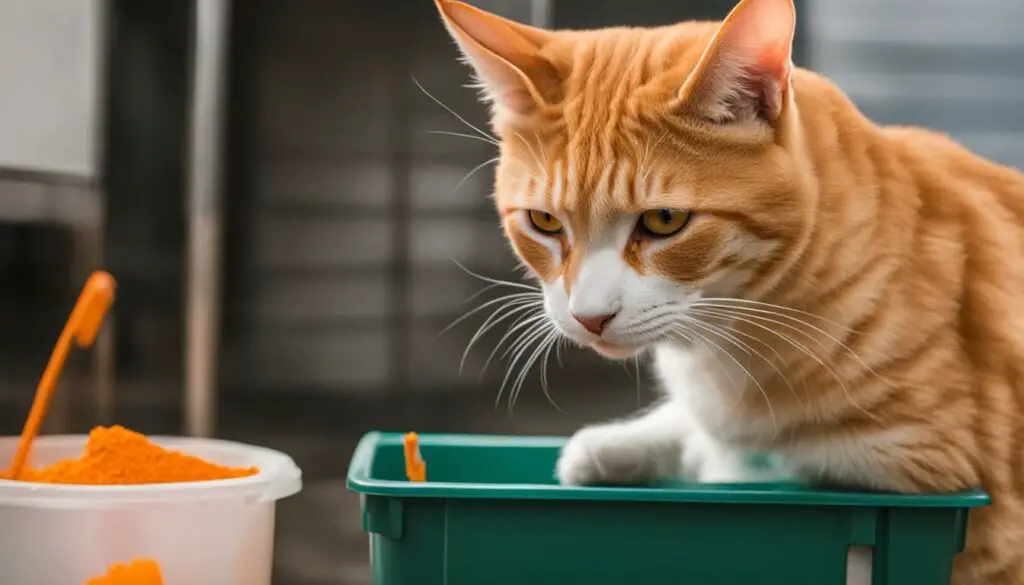
Tips for Retraining an Older Cat
- Introduce the cat to the litter box gradually, allowing them to explore and become comfortable with it at their own pace.
- Ensure the litter box is easily accessible for the older cat, taking their mobility and any joint pain into consideration.
- Keep the litter box clean and free from any unpleasant odors, as older cats can be more sensitive to smells.
- Consider using a litter box with lower sides to facilitate easy entry and exit for older cats.
Reasons for Cats to Stop Using the Litter Box
When it comes to cat litter training, there can be various reasons why cats may suddenly stop using the litter box. As responsible pet owners, it is important for us to understand these reasons and take appropriate measures to address them. Here are some common causes for cats to avoid the litter box:
- Changes in the environment: Cats are creatures of habit and any major changes in their surroundings can disrupt their litter box habits. This can include moving to a new home, rearranging furniture, or introducing new pets.
- Issues with the litter box itself: Cats have preferences when it comes to their litter box. If the litter box is too dirty, too small, or has a hood that makes them feel trapped, they may choose to eliminate elsewhere.
- Medical issues: Cats may also stop using the litter box due to underlying medical conditions such as urinary tract infections (UTIs) or bladder stones. These conditions can cause discomfort or pain, leading the cat to associate the litter box with negative experiences.
It is important to take these factors into consideration and address them in order to encourage your cat to use the litter box again. If your cat is displaying litter box avoidance behavior, it is always a good idea to consult with a veterinarian to rule out any underlying medical issues. Once any medical conditions have been addressed, you can focus on creating a positive litter box environment for your cat.
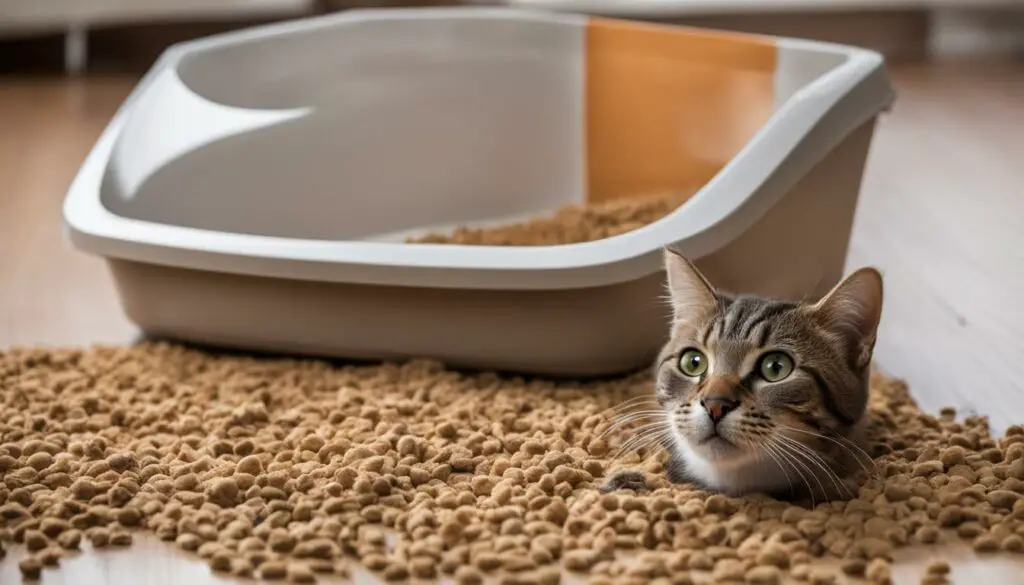
| Reason for Litter Box Avoidance | Solution |
|---|---|
| Changes in the environment | Gradually introduce the changes and provide a familiar and accessible litter box in the new environment. |
| Issues with the litter box itself | Ensure the litter box is clean, the right size, and free from any obstructions. Experiment with different types of litter to find the one your cat prefers. |
| Medical issues | Consult with a veterinarian to diagnose and treat any underlying medical conditions. Provide a comfortable and easily accessible litter box. |
Conclusion
In conclusion, proper litter box training is vital for maintaining a cat’s hygiene and overall well-being. By understanding a cat’s behavior and preferences, we can ensure they use the litter box consistently and avoid accidents in the house.
Choosing the right litter box is crucial for successful training. Whether it’s an open or covered box, we should consider the size and accessibility that suits our cat’s needs. Additionally, selecting the proper litter is important as cats prefer unscented options and may avoid clumping litter. Maintaining a clean litter box is essential, as cats prefer a tidy environment and may avoid dirty boxes.
To introduce our cats to the litter box, we should provide positive reinforcement and show them the location of the box. By establishing a serene litter box location in a quiet and private spot, we create an inviting space for our cats to do their business. It’s important to avoid punishment and focus on positive reinforcement, praising and rewarding our cats when they use the litter box correctly.
While kittens usually adapt to litter box training instinctively, older cats may require retraining in a new environment. Transitioning gradually from soil to cat litter can help familiarize older cats with the litter box. If our cats stop using the litter box, it’s essential to address the underlying cause, whether it’s a change in the environment or a medical issue like UTIs or joint pain.
By following these guidelines and considering our cats’ needs, we can master the art of retraining our cats to use the litter box after a UTI or any other issue. With consistency, patience, and a little understanding, we can ensure our furry friends have a clean and appropriate place to take care of their business.
FAQ
Why is potty training important for cats?
Potty training is important for cats to ensure they use the litter box instead of inappropriate places.
Is litter box training difficult?
No, litter box training is simple and requires minimal training.
What do cats prefer in a litter box?
Cats prefer consistency and need a clean and accessible litter box.
How does the type of litter box and litter used affect a cat’s preference?
The type of litter box and litter used can affect a cat’s preference for using it.
What problems can occur if a cat doesn’t pick up litter box training?
Cats who don’t pick up litter box training can cause disruptions in the household.
How important is consistency and cleanliness for cats using the litter box?
Cats prefer consistency and a clean and peaceful place to do their business.
Why is litter box training essential for a cat’s well-being?
Litter box training is essential for a cat’s hygiene and overall well-being.
How important is choosing the right litter box?
Choosing the right litter box is crucial for successful litter box training.
What are the pros and cons of different types of litter boxes?
Different types of litter boxes have pros and cons.
How should I choose the size of the litter box?
Consider the size of the litter box based on the cat’s size and preference.
Do cats prefer covered or open litter boxes?
Some cats prefer covered boxes, while others prefer open boxes.
Does the type of litter used affect a cat’s preference for using the litter box?
The type of litter used can affect a cat’s preference for using the litter box.
What litter depth is ideal for cats?
Litter depth should be enough for the cat to bury waste.
How should I introduce a cat to the litter box?
Proper introduction to the litter box is important for cats to understand its purpose.
What steps can I take to introduce a cat to the litter box?
Place the cat in the litter box and provide positive reinforcement. Show the cat the location of the litter box and allow them to explore it.
Where should I place the litter box?
Choose a quiet and private spot for the litter box. Avoid placing the litter box near loud appliances or high-traffic areas.
Why is accessibility important for cats using the litter box?
Accessibility and ease of reaching the litter box are important for cats.
How often should I clean the litter box?
Cats prefer clean litter boxes and may avoid dirty ones. Scoop the litter box daily and replace the litter as needed. Clean the litter box with cat-safe cleansers on a regular basis.
What should I do if my cat has accidents outside the litter box?
Cat accidents outside the litter box may require detective work to determine the cause. Experimenting with litter box size and litter type can help resolve accidents.
Can medical issues cause cats to avoid the litter box?
Medical issues like UTIs or bladder stones can cause cats to avoid the litter box.
Should I scold or punish my cat for litter box accidents?
Scolding or punishing a cat for litter box accidents can worsen the problem. Positive reinforcement is key to successful litter box training.
How long does it take for cats to learn litter box training?
Kittens usually learn to use the litter box instinctively, while others may take a few days to a few weeks to adapt. Consistency and patience are necessary during the training period.
How can I retrain an older cat to use the litter box?
Older cats are usually already litter trained but may require adjustment in a new environment. Using soil from outside can help familiarize the cat with the litter box. Gradually transition to cat litter from soil.
Why do cats stop using the litter box?
Cats may stop using the litter box due to various reasons, including changes in the environment or litter type. Medical issues such as joint pain or UTIs can also cause litter box avoidance. Addressing the underlying cause is crucial to resolving the issue.
What are the key aspects of successful litter box training?
Litter box training is an important aspect of cat care and hygiene. Proper litter box selection, cleanliness, and positive reinforcement are key to successful training. Understanding a cat’s preferences and addressing any underlying issues can help maintain litter box use.

